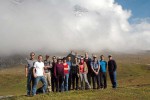In late 2008, Niwot Ridge (NWT) LTER graduate students and scientists attended a workshop in Lausanne Switzerland organized by a research group headed by Antoine Guisan at the University of Lausanne. Funded by the International Program of the National Science Foundation (NSF), the objectives of the workshop were threefold:
- To combine European and American expertise to evaluate the threat of climate change to plant diversity at high-elevations (alpine and subalpine ecosystems)
- To train American graduate students in the use of state-of-the-art species distribution models
- To establish better collaboration between European and American scientists working in high-elevation ecosystems
Graduate student Anthony Darrouzet-Nardi blogged the workshop at http://anthony.darrouzet-nardi.net/scienceblog/. The following account is excerpted from his blog.
At the Niwot Ridge, a lot of the research is focused on understanding ecological processes such as biogeochemical cycles and the biotic interactions of plants, which the workshop dubbed a "process-based" approach. In contrast, the group in Lausanne uses a statistical modeling approach that measures species distribution in the field and then attempts to back out (extrapolate?) the conditions under which they occur in order to make predictions about other places or times. This might be called a "statistical modeling" approach.
During discussions at the meeting, we talked about how these two approaches complement each other and how they might be combined to make better projections of species distributions and ecosystem processes. The advantage of using Niwot Ridge's process-based approach is that mechanistic knowledge improves our power to make predictions. The disadvantage is that, in order to focus on these mechanisms, we typically ignore spatial heterogeneity, which reduces our predictive power. In contrast, the spatial statistical modeling does a good job of incorporating differences over large areas, but does not have the mechanistic basis of the process-based models.
We discussed how we could combine the two approaches, and it was a brain twister. However, a post-doc working with Antoine Gusian and the intellectual lead of the workshop, Chris Randin, put forward an idea that we could use process-based models (like CENTURY) to create spatially explicit layers that can be used in statistical modeling. This type of approach had not, to our knowledge, been used for ecosystem modeling before. In subsequent discussions, we delved further into how the two approaches complemented each other and how they could be used together to make better projections of species distributions and ecosystem processes in a changing climate.
The collaborations initiated at this workshop are continuing. In particular, Chris Randin received a post-doc from the Swiss equivalent of NSF to test his novel approach with the NWT LTER team in Boulder Colorado, and was in residence from January-June 2009.

 Enlarge this image
Enlarge this image